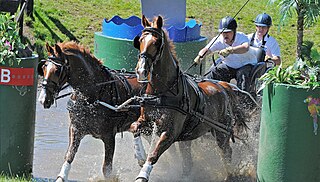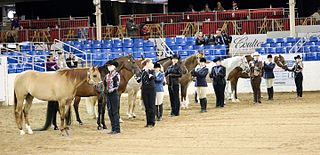Related Research Articles

The American Quarter Horse, or Quarter Horse, is an American breed of horse that excels at sprinting short distances. Its name is derived from its ability to outrun other horse breeds in races of a quarter mile or less; some have been clocked at speeds up to 55 mph (88.5 km/h). The development of the Quarter Horse traces to the 1600s.
Tack is equipment or accessories equipped on horses and other equines in the course of their use as domesticated animals. Saddles, stirrups, bridles, halters, reins, bits, harnesses, martingales, and breastplates are all forms of horse tack. Equipping a horse is often referred to as tacking up. A room to store such equipment, usually near or in a stable, is a tack room.

Show jumping, also known as "stadium jumping", is a part of a group of English riding equestrian events that also includes dressage, eventing, hunters, and equitation. Jumping classes are commonly seen at horse shows throughout the world, including the Olympics. Sometimes shows are limited exclusively to jumpers, sometimes jumper classes are offered in conjunction with other English-style events, and sometimes show jumping is but one division of very large, all-breed competitions that include a very wide variety of disciplines. Jumping classes may be governed by various national horse show sanctioning organizations, such as the United States Equestrian Federation in the USA or the British Showjumping Association in Great Britain. International competitions are governed by the rules of the International Federation for Equestrian Sports. Horses are very well-known for jumping in competition or even freely.

Eventing is an equestrian event where a single horse and rider combine and compete against other competitors across the three disciplines of dressage, cross-country, and show jumping. This event has its roots in a comprehensive cavalry test that required mastery of several types of riding. The competition may be run as a one-day event (ODE), where all three events are completed in one day or a three-day event (3DE), which is more commonly now run over four days, with dressage on the first two days, followed by cross-country the next day and then show jumping in reverse order on the final day. Eventing was previously known as Combined Training, and the name persists in many smaller organizations. The term "Combined Training" is sometimes confused with the term "Combined Test", which refers to a combination of just two of the phases, most commonly dressage and show jumping.

Equestrianism, commonly known as horse riding or horseback riding, includes the disciplines of riding, driving, or vaulting with horses. This broad description includes the use of horses for practical working purposes, transportation, recreational activities, artistic or cultural exercises, and competitive sport.

Rodeo is a competitive equestrian sport that arose out of the working practices of cattle herding in Spain and Mexico, expanding throughout the Americas and to other nations. It was based on the skills required of the working vaqueros and later, cowboys, in what today is the western United States, western Canada, and northern Mexico. Today, it is a sporting event that involves horses and other livestock, designed to test the skill and speed of the cowboys and cowgirls. American style professional rodeos generally comprise the following events: tie-down roping, team roping, steer wrestling, saddle bronc riding, bareback bronc riding, bull riding and barrel racing. The events are divided into two basic categories: the rough stock events and the timed events. Depending on sanctioning organization and region, other events such as breakaway roping, goat tying, and pole bending may also be a part of some rodeos.

Barrel racing is a rodeo event in which a horse and rider attempt to run a cloverleaf pattern around preset barrels in the fastest time. Though both sexes compete at amateur and youth levels, in collegiate and professional ranks, it is usually a rodeo event for women. It combines the horse's athletic ability and the horsemanship skills of a rider in order to safely and successfully maneuver the horse around three barrels placed in a triangle pattern within a large arena.

Cross country equestrian jumping is an endurance test that forms one of the three phases of the sport of eventing; it may also be a competition in its own right, known as hunter trials or simply "cross-country", although these tend to be lower-level, local competitions.
A halter or headcollar is headgear that is used to lead or tie up livestock and, occasionally, other animals; it fits behind the ears, and around the muzzle. To handle the animal, usually a lead rope is attached. On smaller animals, such as dogs, a leash is attached to the halter.

Skijoring is a winter sport in which a person on skis is pulled by a horse, a dog or a motor vehicle. It is derived from the Norwegian word skikjøring, meaning "ski driving". Although skijoring is said to have originated as a mode of winter travel, it is currently primarily a competitive sport.
Agility Association of Canada (AAC) is a dog agility organization in Canada. Agility began in Canada when Art Newman, of North Gower, Ontario, founded what was then referred to as the Agility Dog Association of Canada in 1988. It quickly spread from central Ontario outwards to ultimately encompassing almost all of the provinces and territories. As of June 2005, there were 103 officially recognised membership clubs listed and hundreds of unofficial clubs thriving throughout Canada.

The National Finals Rodeo, organized by the Professional Rodeo Cowboys Association (PRCA), is the premier championship rodeo event in the United States. The NFR showcases the talents of the PRCA's top 15 money-winners in each event as they compete for the world title.

Combined driving is an equestrian sport involving carriage driving. In this discipline, the driver sits on a vehicle drawn by a single horse, a pair or a team of four. The sport has three phases: dressage, cross-country marathon and obstacle cone driving, and is most similar to the mounted equestrian sport of eventing. It is one of the ten international equestrian sport horse disciplines recognized by the Fédération Équestre Internationale (FEI); combined driving became an FEI discipline in 1970.

Showmanship is an event found at many horse shows. The class is also sometimes called "Fitting and Showmanship", "Showmanship In-Hand", "Showmanship at Halter" or "Halter Showmanship" It involves a person on the ground leading a horse, wearing a halter or bridle, through a series of maneuvers called a pattern. The horse itself is not judged on its conformation. Rather, the exhibitor is judged on how well he or she exhibits the animal to its best advantage, with additional scoring for the grooming and presentation of both horse and handler.

Western riding is considered a style of horse riding which has evolved from the ranching and welfare traditions which were brought to the Americans by the Spanish Conquistadors, as well as both equipment and riding style which evolved to meet the working needs of the cowboy in the American West. At the time, American cowboys had to work long hours in the saddle and often over rough terrain, sometimes having to rope a cattle using a lariat, also known as a lasso. Because of the necessity to control the horse with one hand and use a lariat with the other, western horses were trained to neck rein, that is, to change direction with light pressure of a rein against the horse's neck. Horses were also trained to exercise a certain degree of independence in using their natural instincts to follow the movements of a cow, thus a riding style developed that emphasized a deep, secure seat, and training methods encouraged a horse to be responsive on very light rein contact.
Trail is a competitive class at horse shows where horses and riders in western-style attire and horse tack navigate a series of obstacles. Contestants ride the course one at a time. Originally designed to resemble situations a horse and rider might actually encounter when on a trail in a natural habitat, modern trail classes now tend to focus more heavily on agility and manners, with courses bearing very little resemblance to real-world natural trails.
The history of dog agility can be traced to a demonstration in the late 1970s in the United Kingdom. It has since spread rapidly around the world, with major competitions held worldwide.

A lead, lead line, lead rope (US) or head collar rope (UK), is used to lead an animal such as a horse. Usually, it is attached to a halter. The lead may be integral to the halter or, more often, separate. When separate, it is attached to the halter with a heavy clip or snap so that it can be added or removed as needed. A related term, lead shank or lead chain refers to a lead line with a chain attached that is used in a variety of ways to safely control possibly difficult or dangerous horses if they will not respond to a regular lead.

Dog agility is a dog sport in which a handler directs a dog through an obstacle course in a race for both time and accuracy. Dogs run off leash with no food or toys as incentives, and the handler can touch neither dog nor obstacles. Consequently, the handler's controls are limited to voice, movement, and various body signals, requiring exceptional training of the animal and coordination of the handler.

This is a basic glossary of equestrian terms that includes both technical terminology and jargon developed over the centuries for horses and other equidae, as well as various horse-related concepts. Where noted, some terms are used only in American English (US), only in British English (UK), or are regional to a particular part of the world, such as Australia (AU).
References
- 1 2 "The Competition - Federation of International Horse Agility Clubs". Fihac.com. Retrieved 2014-04-16.
- ↑ "Horse Agility World Champion Hawkwell Versuvius | Eventing Nation - Three-Day Eventing News, Results, Videos, and Commentary". Eventing Nation. 2013-01-05. Retrieved 2014-04-16.
- ↑ "FAQ's | Agility For Horses - USA". Agility For Horses. Retrieved 2014-04-16.
- ↑ "Competitive Horse Agility | The International Horse Agility Club". Thehorseagilityclub.com. Retrieved 2014-04-16.
